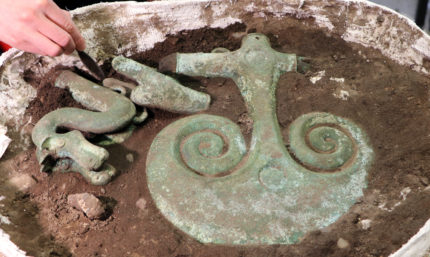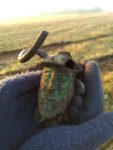 An archaeological survey at the site of a planned gravel pit expansion in Kallerup, Denmark, this February unearthed an exceedingly rare grouping of Bronze Age artifacts: a man wearing a horned helmet, a large ceremonial axe and two horse-headed snake figures. They were made of bronze about 3,000 years ago.
An archaeological survey at the site of a planned gravel pit expansion in Kallerup, Denmark, this February unearthed an exceedingly rare grouping of Bronze Age artifacts: a man wearing a horned helmet, a large ceremonial axe and two horse-headed snake figures. They were made of bronze about 3,000 years ago.
It was a metal detectorist volunteering with the team of archaeologists from the Museum Thy who made the initial find. Peter Jensen was scanning the field for remains of a Royal Air Force Stirling airpcraft that was shot down by German bombers on November 4th, 1943. Instead of aluminum airplane parts, his metal detector alerted to the presence of a large piece of bronze.
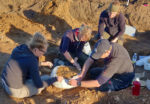 Archaeologists dug it up and recovered a bronze figure of a man topped with a horned helmet. It is double-faced, a Bronze Age Danish Janus, each face with its own pair of horns. (One of them had broken off and was found in the soil.) Nothing like it has been found before in Denmark. It would have originally been fitted to a pole for ceremonial purposes. Next to the broken horn emerged the top of a ceremonial axe a foot in diameter. Instead of continuing to excavate in situ, they removed the find en bloc, wrapping the soil around and under in plaster and transporting it to a laboratory at the Moesgaard Museum.
Archaeologists dug it up and recovered a bronze figure of a man topped with a horned helmet. It is double-faced, a Bronze Age Danish Janus, each face with its own pair of horns. (One of them had broken off and was found in the soil.) Nothing like it has been found before in Denmark. It would have originally been fitted to a pole for ceremonial purposes. Next to the broken horn emerged the top of a ceremonial axe a foot in diameter. Instead of continuing to excavate in situ, they removed the find en bloc, wrapping the soil around and under in plaster and transporting it to a laboratory at the Moesgaard Museum.
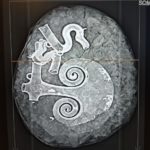 A CT scan revealed the precise shape and location of the axe and the presence of two figurines with the heads of horses and serpentine bodies. The scan gave archaeologists a 3D roadmap for the excavation. After three days of painstaking work, the objects were fully revealed.
A CT scan revealed the precise shape and location of the axe and the presence of two figurines with the heads of horses and serpentine bodies. The scan gave archaeologists a 3D roadmap for the excavation. After three days of painstaking work, the objects were fully revealed.
The axe was cast over a clay core and was a masterpiece of metallurgy in its day. Ceremonial axes from the Bronze Age are rare finds. Large ones like this piece are even more rare. They were made as individual artworks, and 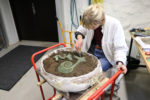 the Kallerup axe is unique in its rounded spade-like edges that end in spirals. Spirals were a widespread motif in Bronze Age religious iconography, but this is the only known axe to incorporate them so distinctly in the design. The two figures of stylized horse heads on long, serpentine necks are also well-known motifs in Bronze Age art.
the Kallerup axe is unique in its rounded spade-like edges that end in spirals. Spirals were a widespread motif in Bronze Age religious iconography, but this is the only known axe to incorporate them so distinctly in the design. The two figures of stylized horse heads on long, serpentine necks are also well-known motifs in Bronze Age art.
The artifacts will be stabilized and conserved. If all goes as planned, they will be put on display in the newly refurbished exhibition space at the Museum Thy when it opens in 2021.
